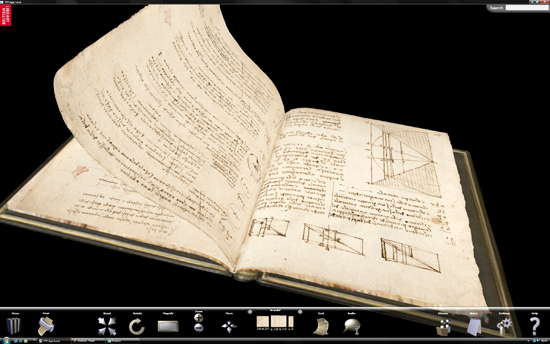|
3DVisA Resources 3DVisA Index of 3D Projects: Palaeography and Manuscript Studies
Turning the Pages 2.0™
Turning the Pages is a technology for creating interactive 3D facsimile of books. It powers an ongoing digitisation programme of the most treasured, illuminated manuscripts and rare books in the British Library and other libraries and archives.
Precious and fragile, these manuscripts should not be exposed to light and physical examination. Their display and direct study are restricted for conservation reasons.
Advanced visualisation techniques made it possible to make interactive digital facsimiles available online. Pages can be turned virtually and
examined in close detail, using a virtual magnifying glass. Mozart’s Musical Diary is accompanied by 75 audio excerpts.

Fig. 1. Turning the Pages: A digital facsimille of Leonardo da Vinci's notebook, known as the Codex Arundel. © The British Library and Armadillo Systems. Reproduced by kind permission.
As of April 2007, thirty works have been digitised, including Leonardo da Vinci’s notebook (Codex Arundel) and Andreas Vesalius’s De Humani Corporis Fabrica,
and some of the greatest religious works of Christian art, such as the Sherborne Missal, Luttrell Psalter, Sforza Hours and the Lindisfarne Gospels
(the latter were the first to be digitised in 1998). Islamic religious texts include Sultan Baybars’ Qur’an, Buddhist Diamond Sutra and Jewish Golden Haggadah. Much of this work has been made possible through the generous sponsorship of individuals and foundations.
The techniques used to create Turning the Pages books have evolved over the years. In 2001, the project entered a new phase when the British Library
started working with new media developers Armadillo Systems to make the books even more realistic and re-engineered the software to make Turning the Pages books available
on the web. In 2007 a new version, TTP 2.0 was launched which provides a more realistic 3-D environment for the books, allowing users to manipulate them in all axes as well as zoom in,
rotate and magnify.
Project dates: Ongoing from 1998.
Resource status: Open-access online resource. Manuscripts digitised under the Turning the Pages programme are available from
the British Library and the Wellcome Library as well as
the National Library of Ireland.
There are also kiosk displays in the galleries of the British Library and terminals in Northumberland, UK; Sherborne, UK; Dublin, Ireland, and at the National
Library of Medicine near Washington, USA.
The Lindisfarne Gospels, the Sherborne Missal and Sultan Baybars’ Qur’an are available on CD-ROMs from the British Library.
Contributors: Developed by the British Library, since 2001 in partnership with a media communication agency,
Armadillo Systems, London.
Sources and further details:
Turning the Pages at Armadillo Systems: Books.
'Turning the Pages 2.0TM wins a top award for excellence and innovation', The British Library Press Release, 12 December 2007.
Record compiled by Anna Bentkowska-Kafel, 11 September 2006. Last updated: 20 December 2007.
3DVisA gratefully acknowledges the help of Michael Stocking with preparation of this record.
© Turning the Pages™ and 3DVisA, 2006.
Back to the list of 3D projects
| 